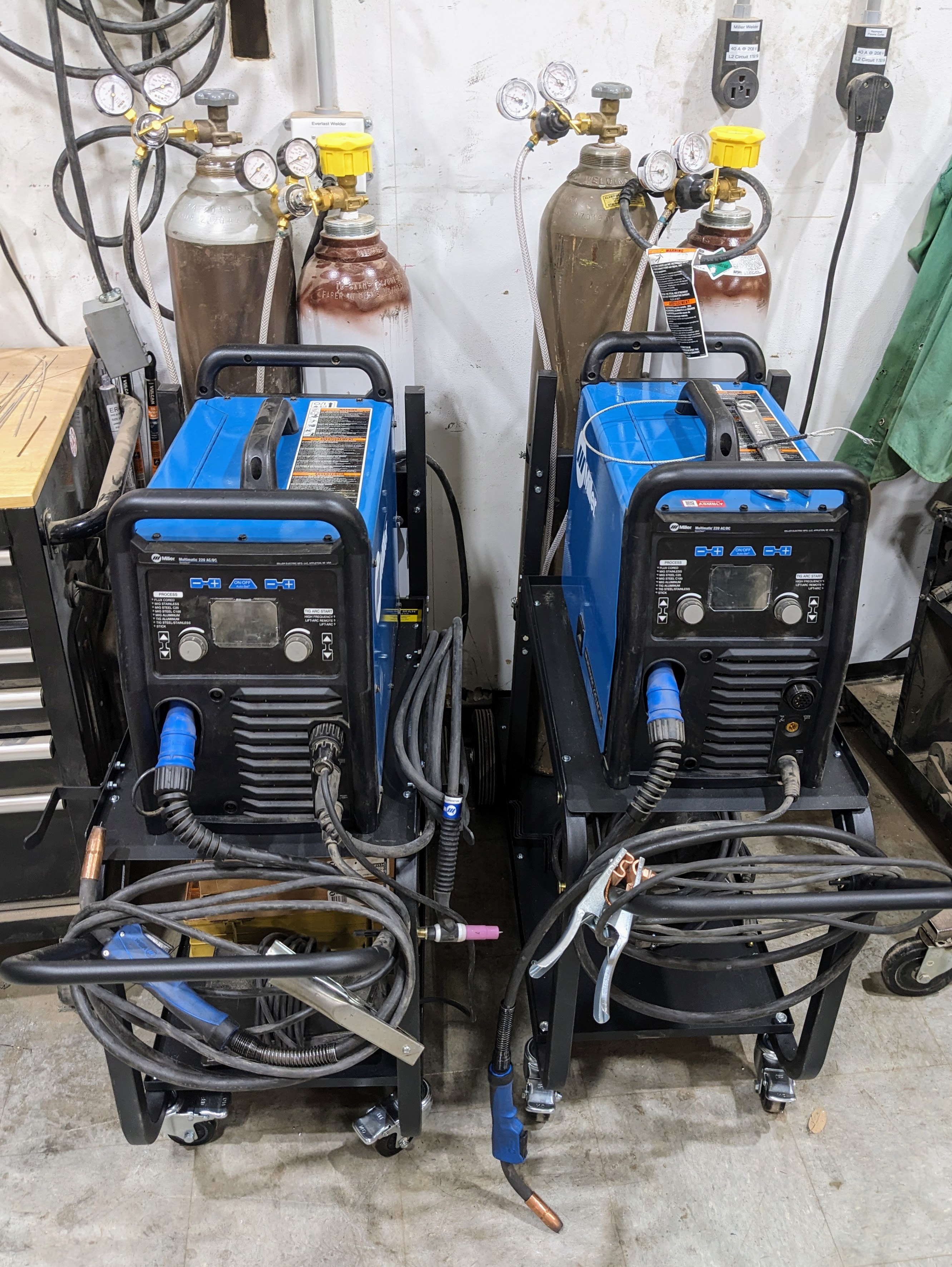Miller Multimatic 220 Welder
Asmbly has two Multimatic 220 multi-process welders. These have both MIG and AC/DC TIG capabilities, each of which has its own prerequisite class. One's owned by Asmbly, the other's hosted by Jon.
![]() Members must complete the MIG Welding Class before using this tool
Members must complete the MIG Welding Class before using this tool
![]() Members must complete the TIG Welding Class before using this tool
Members must complete the TIG Welding Class before using this tool
Safety
Universal Safety
- Be aware of your surroundings, especially when handling large materials.
- Do not approach anyone operating equipment. Stand patiently in their field of view.
- Always wear appropriate personal protective equipment (PPE), including welding gloves, a welding helmet with appropriate shade, flame-resistant clothing, and safety boots.
- Ensure proper ventilation when welding to prevent exposure to fumes and gases.
- Keep flammable materials away from the welding area.
- Do not weld on containers that have held combustibles unless properly prepared.
- Always disconnect power before performing maintenance.
Equipment-Specific Safety
- MIG Welding Class is required to use this tool.
- Do not touch live electrical parts; always assume the workplace and electrode are electrically live.
- Always check that the machine is properly grounded and all cables are securely connected before operation
- Ensure the ground clamp is securely attached to the workpiece.
- Use proper shielding gas to minimize exposure to harmful fumes.
- Keep all covers and panels in place during operation.
- Avoid working in wet or damp environments when operating the equipment.
Etiquette
- Maintain a clean and organized workspace
- Follow safety protocols to minimize risk of injury to yourself or others
- Report any equipment malfunctions
Use Case
The Miller Multimatic 220 AC/DC is a versatile multi-process welder capable of MIG, Stick, and TIG welding, suitable for small fabrication shops, maintenance, and hobbyist applications. It supports both 120V and 240V power inputs for various work environments.
Material Capacity
- Mild Steel 24 ga. - 3/8 in. (MIG)
- Mild Steel 24 ga. - 1/4 in. (TIG)
- Aluminum 24 ga. - 1/4 in. (TIG)
Cleanup
Universal Cleaning Guide
- Always clean up spatter and debris from the work area.
- Store consumables properly to prevent contamination.
- Return the equipment to neutral.
- Sweep up any dust and debris around the tool, your table top, and the floor - both in the equipment area and your work area.
- Clear the floor of any tripping hazards, like power cords.
- Empty trash cans and dust collectors that are halfway full or more into the Asmbly dumpster behind the workshop.
- Leave the shop 110% better than you found it.
Tool Specific Cleaning Guide
- Clean the welding nozzle regularly to prevent spatter buildup.
- Replace contact tips as needed.
- Inspect and clean drive rolls to ensure proper wire feeding.
- Store hoses, cables, and attachments appropriately.
Resources
Common Problems
| Issue | Definition | Possible Causes | Solution |
|---|---|---|---|
| No arc start | Poor ground connection | Ensure ground clamp is attached securely | |
| Excessive spatter | Scattering of molten metal particles that cool to solid form near weld bead. | Incorrect voltage/wire speed.
|
Adjust settings per material thickness
|
| Porosity in weld | Small cavities or holes resulting from gas pockets in weld metal. |
|
Adjust settings per material thickness
|
| Wire feeding issues | Drive roll slippage | Check and clean drive rolls | |
| Incomplete Fusion | Failure of weld metal to fuse completely with base metal or a preceding weld bead. | *Insufficient heat input.
|
|
| Lack of Penetration | Shallow fusion between weld metal and base metal. |
|
|
| Excessive Penetration | Weld metal melts through the base metal and hangs underneath the weld. | Excessive heat input. |
|
| Burn-Through | Weld metal melting completely through base metal resulting in holes where no
metal remains. |
Excessive heat input. |
|
| Waviness Of Bead | Weld metal that is not parallel and does not cover joint formed by base metal. | Unsteady hand. |
|
| Distortion | Contraction of weld metal during welding that forces base metal to move. | Excessive heat input. |
|
Maintenance
This tool is owned by Asmbly Makerspace for the use of its members. Please submit a problem report if maintenance is required.
Maintenance
This tool is owned by Jon Eklund and hosted at Asmbly for members to use. Please submit a problem report if maintenance is required.
